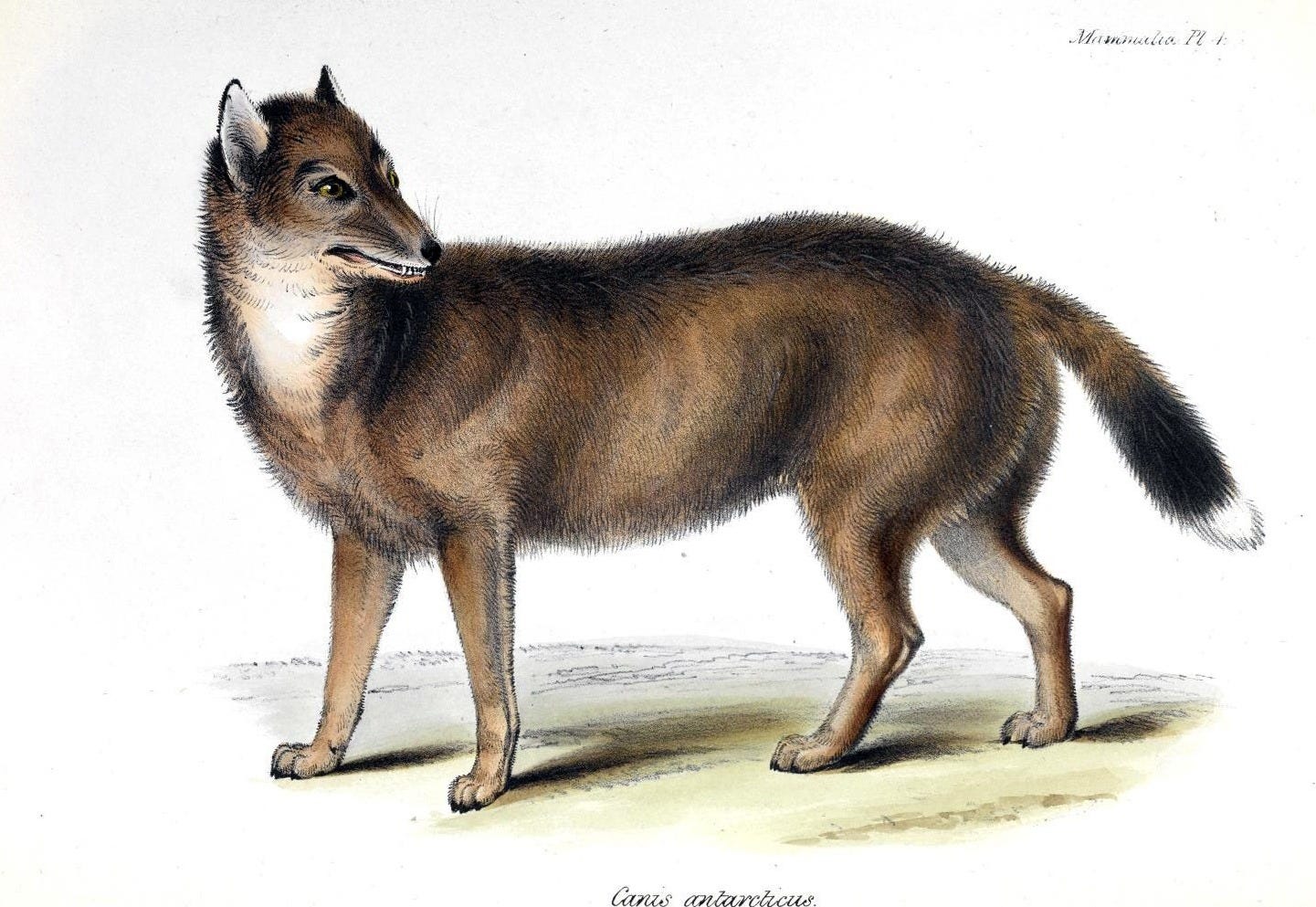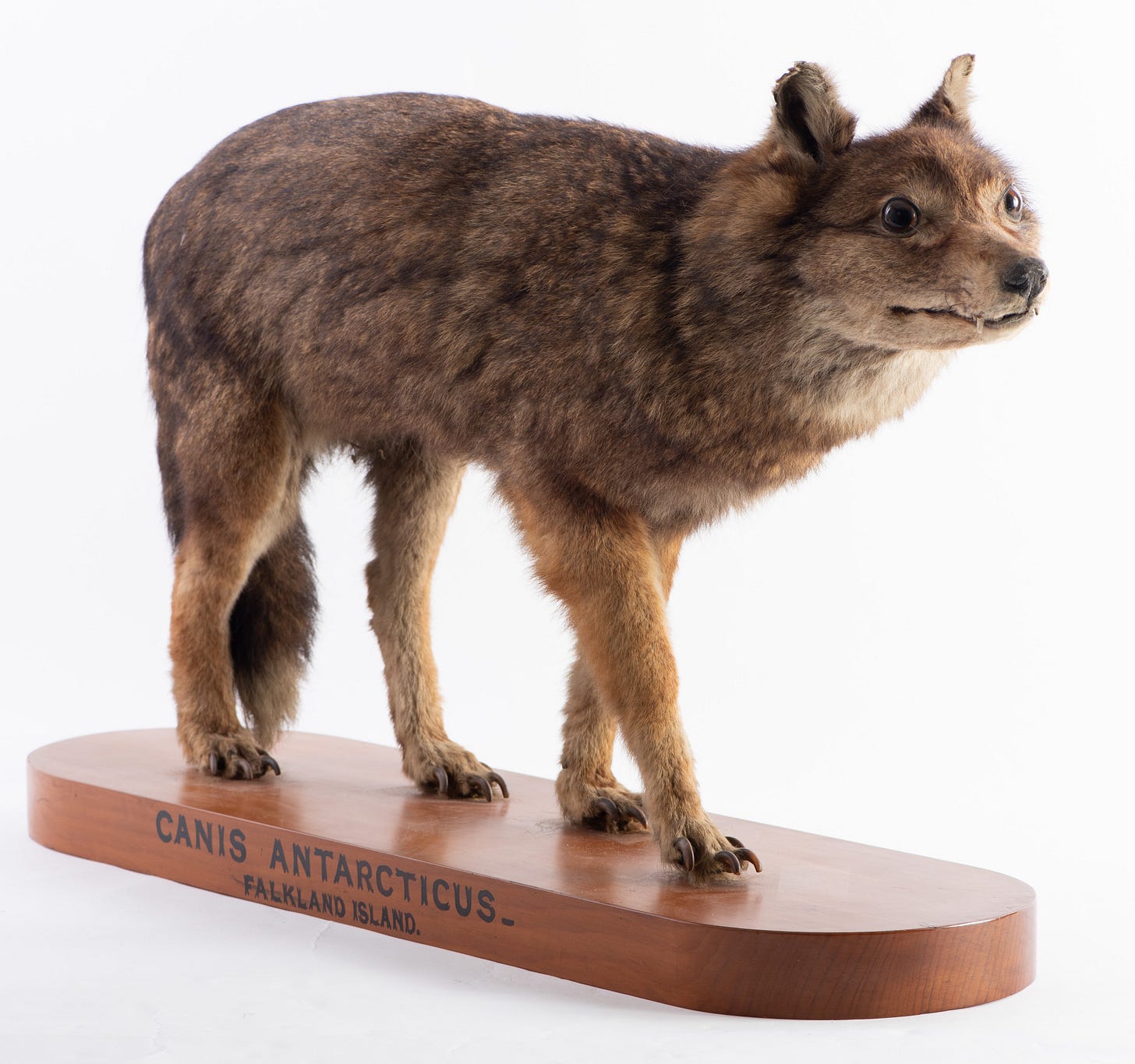The Curious Case of an Unfamiliar Wolf
And a sad tale of how humans rip out the very meaning of humanity through their greed.

The Atlantic Ocean might harbour fewer islands when compared to its elder filial water body, the Pacific, but it does have some interesting contenders dotting its blue.
Among them, close to Argentina’s southernmost Santa Cruz Province, you’ll find a smattering of islands. These are the Falklands, an archipelago named after the strait that separates the two main islands, conveniently named East and West Falkland.
Interesting to note here is the fact that there existed no native population before the Europeans planted their feet. While there might not have been any homo sapiens here, there did exist flora and fauna—some unique to the islands.
We often have scores of pages dedicated to the history of local occupation, particularly bloody when viewed through the lens of colonisation. But what about animals lost to human greed? Let’s get this straight: We’re not here to talk about anthropology or the geography of these islands. Nor are we discussing the occupation of Europeans that brought this archipelago fame.
Rather, the focus is on what brought the islands infamy—at least in my eyes—when the new inhabitants drove a curious native population to extinction.
All for their so-called survival.
Warrah of the Falklands
Before we move ahead, here’s something that’s been puzzling me.
The domestication of the wolf (I don’t know why they call it domestication of the dog) began when hunter-gatherer humans came face to face with canids in Europe nearly 45,000 years ago. These ancestors of modern-day dogs and wolves were curious beasts, in that while they were very much competitors to the then-humans we know, there was a different switch in their fight-or-flight mechanics—a switch that made them daringly approach humans. Not to hunt, no, but probably to share a kill. The quadruped pack hunters were sharing the same ecosystem with the new biped pack hunters in the forest.
Think of it this way. Today, if you were to offer a dog, say a Labrador, a chunk of steak, you’ll find yourself a way to befriend that dog. Not that it’d matter in the case of labradors. You might even be able to command it to leave the piece of meat. But go to any tundra in the northern hemisphere that houses grey wolves and try to do the same (actually, don’t) and you’ll find a beast that not only crosses your boundaries with assertiveness, but also looks you dead in the eye while doing so, establishing a dominance that sends chills down your spine. That is, if a) it doesn’t run away from you, as wolves avoid humans, or b) the pack doesn’t prey on you.
Both are completely different, even though they share a common ancestor.
But imagine, just for a moment, a wolf, or possibly a fox descendant that looks like a wolf, who is wild, untamed, and unharmed in a new ecosystem in which Europeans arrive. This canid, despite never coming in contact with humans, is very much a curious and tame pup. And it’s not competing in the same ecological niche, either. Just a friendly, neighbourhood wolf that is more labrador-like in its demeanour.
Despite this, the newly arrived bipedal humans forget to use their noggins (an advantageous organ, considering evolution) and wipe out the poor wolf for their survival.
This is how the warrahs, or the Falkland Islands wolves, found a fate no different from dodos. To quote the aforementioned famous explorer and naturalist on H.M.S. Beagle, in a record from his journey to chart the species of the world:
“Within a very few years after these islands shall have become regularly settled, in all probability this fox will be classed with the dodo.”
Fall of the Fearless

Charles Darwin states the following in The Voyage of the Beagle about the subject of our discussion:
“The only quadruped native to the island is a large wolf-like fox (Canis antarcticus), which is common to both East and West Falkland. I have no doubt it is a peculiar species, and confined to this archipelago; because many sealers, Gauchos, and Indians, who have visited these islands, all maintain that no such animal is found in any part of South America.”
Canis antarcticus, as Darwin calls it . . . a name that won’t last long as its classification.
When the tail-less ape, in all its civilizational, post-renaissance enlightenment glory, set foot on the shores of the Falkland Islands, nature was at its best: undisturbed and unperturbed. But things were about to change.
Now, there are various claims to who came first, as is the tradition among European powers to lay claim and squabble over the matters and land they don’t belong to. We shall, however, stick to what the official government of the Falkland Islands describes on its website:
“The Falkland Islands have never had any native inhabitants and no indigenous people have ever been displaced, instead the Islands were entirely unoccupied until 1765, when they were first claimed by the British who established a garrison at Port Egmont. Over the years, the British, French and Spanish periodically had garrisons within the Islands until 1811 when all were withdrawn.”
But they later did return, especially the British. These usual colonial suspects, having solidified their footing on the Falkland Islands—and even naming it after one of their own—then began to settle in a fashion not unlike their typical ways. That is to say, they did away with everything that didn’t suit them and brought in all that helped them survive a place that was rather too hospitable. But it wasn’t just Scotts and Brits; there were Argentinians and Americans flocking to leave their ligature marks on the neck of these woods.
More often than not, they’d be greeted by the curious and friendly warrahs. The only mammal residents of the islands that were frequented by ocean-faring species, these wolves did not have an apex predator challenging their territories. So they roamed freely, bringing their snout to greet anything and everything—even the arriving boats—with great enthusiasm and friendliness, as their wagging tails made obvious.
Unfortunately, this very tameness and lack of fear in the face of a new species on the island sealed their fate. In a completely unexpected (to us) move, the islanders began to fell the friendly beasts.
As Darwin noted, the wolves were nosy and were treated as vermin. But this makes for a far more unfounded and wretched reason for this culling, don’t you think? Although they did scavenge stuff here and there, these animals mostly included birds, rodents, and eggs in their diet. The ever-enlightened European, however, saw their fur as a commodity to exploit. They also condemned the animals to keep their sheep safe.
In More Natural History Essays (entry on page 77), Graham Renshaw remarked that warrah, or the Antarctic Wolf, had developed a taste for sheep. Now, there are various claims as to whether this really was the case or if it was some budding fur industry that led to its demise, given how the sheep saw a dog in these wolves . . . a dog they assumed to be their predator, just like their homeland.
After it had been wiped out—hunted easily thanks to its approachability–from the face of these islands, its dead remnants were studied with vigour by naturalists and taxonomists alike. One Oldfield Thomas, from the comfort of his offices in London, left a permanent epitaph on the warrah’s cold grave in the form of a new binomial name—Dusicyon australis: foolish dog of the South.
An Ode to What Could Have Been
There’s a particular bond that we share with domesticated animals. Look at the dogs, a direct comparison to the thread I’ve woven in the paragraphs above. A third Latin name added to the Canis lupus (wolf) gives us Canis lupus familiaris. Wolf friend, ergo, dog.
And we adore them. You need only turn to Instagram or TikTok to find a flood of dog-related posts, cherished deeply by the billions. Yet, here is an account of a wolf that was very much friendly, tame, possibly primed to be Canis antarcticus familiaris. All we’re left with, though, are some shoddy sketches, museum specimens, and details of sightings that you and I will never get to witness.
Yes, we lost the mammoths. Yes, we lost the Carolina parakeet. Yes, we lost the dodos. But there’s a poetic disgrace in losing an animal so taxonomically close to our modern companions. Man’s best friend, we call our dogs, don’t we? Constant companions in our worst and in our best. This loss aches me deeply, what with a shih-tzu in my family. There’s a hollowness in this feeling, too. How do you mourn a loss you couldn’t witness?
Had the warrah not been driven to extinction, would they have become our companions? A different breed of wolf-derived dogs, fox-like in their mannerisms? We can’t possibly know. But knowing how we’ve driven many animals close to the same fate as that of these ghosts of the Falkland past, there’s no denying that death might have come either way.
We, the ever-so resilient, survivalist, and evolutionary codpieces of progress, continue to mangle the planet. It might not be greed for the warrah’s fur today, but there is a great demand for rhinoceros horns, elephant tusks, shark fins, and tiger penises to craft eye- or virility-candies. Survival of the fittest? Smartest? Libidinous? Fur or no fur, we have transcended to a higher plane of existence.
Perhaps the anthropologists should petition to revise history books post the industrial revolution to classify us with a third Latin addition, a subspecies modifier to band us together under this very real utopia that celebrates our undying hunger to conquer it all: Homo sapiens rapax.
References:
Collins, Richard. “‘Warrah’ Mystery Solved at Last.” Irish Examiner, 18 Mar. 2013, https://www.irishexaminer.com/opinion/columnists/arid-20225784.html.
Dzombak, Rebecca. “New Clues May Explain the Mysterious Origins of the Falklands Wolf.” National Geographic, 27 Oct. 2021, https://www.nationalgeographic.com/animals/article/falkland-islands-wolf-fox-origin-people.
Falkland Islands Government. Our History. https://www.falklands.gov.fk/our-history.
Kemp, Christopher. “Lone Wolf: The Beast That Shouldn’t Have Been.” New Scientist, 8 May 2013, https://www.newscientist.com/article/mg21829162-100-lone-wolf-the-beast-that-shouldnt-have-been/.
Kozloff, Nikolas. “The Enduring Mystery of Darwin’s Warrah.” Salon, 19 Jun. 2024, https://www.salon.com/2024/06/19/the-warrah-enigma-why-darwin-was-fascinated-by-this-now-extinct-coyote-like-creature/.
Morell, Virginia. “How Wolf Became Dog.” Scientific American, 1 Jul. 2015, https://www.scientificamerican.com/article/how-wolf-became-dog/.
“Rare & Extinct Creatures: Warrah or Falkland Islands Wolf.” Messy Beast, http://messybeast.com/extinct/warrah.htm.
Renshaw, Graham. More Natural History Essays. Sherratt & Hughes, 1905, https://www.biodiversitylibrary.org/item/36717.




Thought this was great, Jagi. I never knew the warrah was actually gentle and docile and, like many animals, was exploited by humans.
I've never heard of Warrahs but I've definitely seen that sketch. Poor wolves got extinct by the very humans they were friendly towards.